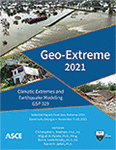Assessment of Liquefaction Effects on Ground Motion Frequency Parameters for Accelerogram-Based Liquefaction Detection
Publication: Geo-Extreme 2021
ABSTRACT
An accelerogram-based method has been recently developed to quickly assess the liquefaction occurrence using only the ground-motion records. In this method, two frequency-related ground-motion parameters, the richness of the low-frequency components (termed RL), and the temporal variation rate of the mean instantaneous frequency (termed MIFr), are extracted from accelerograms and used as explanatory variables of a logistic regression model that outputs a new probability indicator of liquefaction occurrence (termed LQI). This method achieves an overall accuracy of over 90% when classifying the liquefaction occurrence in both the training dataset and the validation dataset, and the method shows promising potential for applications in real-time disaster mitigation systems and rapid postearthquake loss estimations. However, the success of detecting liquefaction from accelerograms relies on the assumption that the liquefaction effect on the site-specific ground motions is more significant than other effects. In this study, we select eight factors representing the source, path, and site effects of a ground-motion record, and conduct correlation analyses between the eight independent factors and the proposed two frequency-related ground-motion parameters (RL and MIFr). The results reveal that, in general, liquefaction has a more significant effect on the site-specific ground-motion frequency parameters compared to other factors such as earthquake source, path, and site effects, which is the basis of the accelerogram-based liquefaction assessment methods. This study will benefit the advancement of the accelerogram-based methods for rapid liquefaction assessment.
Get full access to this article
View all available purchase options and get full access to this chapter.
REFERENCES
Bonilla, L. F., Archuleta, R. J., and Lavallée, D. (2005). “Hysteretic and dilatant behavior of cohesionless soils and their effects on nonlinear site response: Field data observations and modeling.” Bulletin of the Seismological Society of America, 95(6), 2373–2395.
Bozorgnia, Y., Stewart, J., and Abrahamson, N. (2020). “Data resources for NGA subduction project.” Pacific Earthquake Engineering Research Center, USGS.
Gingery, J. R., Elgamal, A., and Bray, J. D. (2015). “Response spectra at liquefaction sites during shallow crustal earthquakes.” Earthquake Spectra, 31(4), 2325–2349.
Kostadinov, M. V., and Yamazaki, F. (2001). “Detection of soil liquefaction from strong motion records.” Earthq. Eng. Struct. Dyn., 30(2), 173–193.
Kramer, S. L., Asl, B. A., Ozener, P., and Sideras, S. S. (2015). “Effects of liquefaction on ground surface motions.” Perspectives on Earthquake Geotechnical Engineering, Springer, 285–309.
Ott, R. L., and Longnecker, M. T. (2015). An introduction to statistical methods and data analysis. Nelson Education.
Régnier, J., Cadet, H., Bonilla, L. F., Bertrand, E., and Semblat, J.-F. (2013). “Assessing nonlinear behavior of soils in seismic site response: Statistical analysis on kik-net strong-motion data.” Bulletin of the Seismological Society of America, 103(3), 1750–1770.
Shimizu, Y., Watanabe, A., Koganemaru, K., Nakayama, W., and Yamazaki, F. (2000). “Super high-density realtime disaster mitigation system.” Proceedings of the 12th World Conference on Earthquake Engineering, number 2345, New Zealand Society for Earthquake Engineering, Auckland, New Zealand (30 January-4 February).
USGS. (2020). “Vs30 Models and Data” USGS website <https://www.usgs.gov>(Oct. 2, 2020).
Van Houtte, C., Bannister, S., Holden, C., Bourguignon, S., and McVerry, G. (2017). “The new zealand strong motion database.” Bulletin of the New Zealand Society for Earthquake Engineering, 50(1), 1–20.
Youd, T. L., and Carter, B. L. (2005). “Influence of soil softening and liquefaction on spectral acceleration.” J. Geotech. Geoenviron., 131(7), 811–825.
Zhan, W., and Chen, Q. (2021). “An accelerogram-based method for quick assessment of liquefaction occurrence.” J. Geotech. Geoenviron., in press.
Information & Authors
Information
Published In
Copyright
© 2021 American Society of Civil Engineers.
History
Published online: Nov 4, 2021
Authors
Metrics & Citations
Metrics
Citations
Download citation
If you have the appropriate software installed, you can download article citation data to the citation manager of your choice. Simply select your manager software from the list below and click Download.
